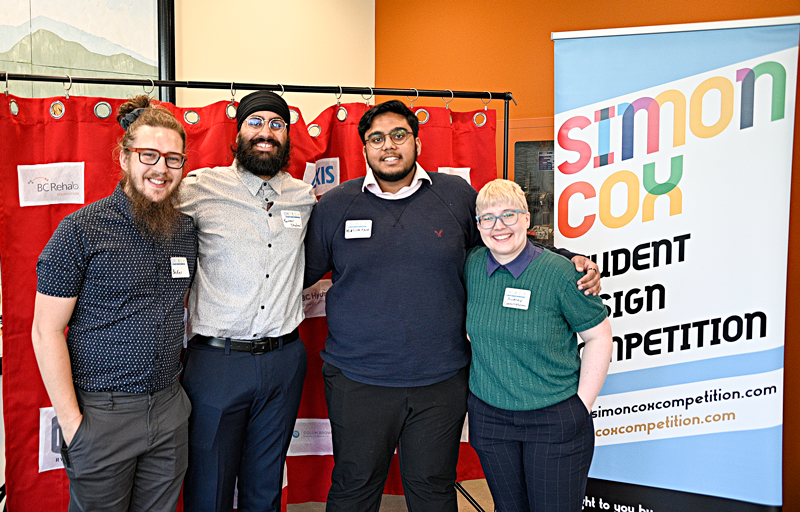For someone with limited mobility, tying their shoelaces can be challenging, but a new device developed by students at UBC Okanagan’s School of Engineering seeks to remove many of the barriers to completing the task.

‘Assistive Shoe Tying Device’ Team: Audrey Cunningham, Becker Salkeld, Kavneer Dhaliwal, Hisham Khan (missing from the image is Chase Anderson Hanaa Diab).
Inspired by ENGR 407 “Inclusive Design,” a group of classmates joined together in search of an inclusive/adaptable project. Working off a list of potential projects provided by Technology for Living. The team decided to seek out investigate ways to enable an individual with Duchenne’s Muscular Dystrophy (DMD) to tie their shoes.
“The individual we were working with was just as concerned about the aesthetics of the potential solution as they were on the functionality and ease-of-use,” explains Audrey Cunningham, the team lead of the “Assistive Shoe Typing Device” team. “We immediately noticed that most (if not all) the commercially available solutions required alterations to the shoe and it was fairly obvious that alterations were made.”
After some initial false-starts where they tried to create a device that enabled a user to tie their shoes in a traditional manner, the team sought out a process that was less complicated but more effective.

“We investigated what was already on the market and aimed to make it sleeker and easier to use, with no modifications to the shoes,” explains Becker Salkeld, who handled much of the CAD modelling and 3D printing aspects of the project.
Starting with a full hoop and hook system, the team tested amongst themselves, friends, and two young boys with autism. They discovered that the design applied too much pressure at the top of the foot, so they revised the prototype to include a half-circle instead of the full hoop.
The team couldn’t say enough about their faculty advisor, Dr. Sabine Weyand, who helped them navigate the design process. “Dr. Weyand has extensive knowledge about the design process, and biomedical applications, and she truly cares about the success of all her students and offers incredible support,” says team member Chase Anderson.
According to team member Hisham Khan, placing first in the Simon Cox Student Design Competition means a lot to the team. “We are particularly proud to know that our work and idea will have a positive impact in the assistive technology world, and hopefully help a great many people achieve some level of independence.”

“This entire project, and what we have learned in our inclusive design course, has inspired us all to continue incorporating inclusive design principles in all our future work, regardless of what area, as inclusive design is human design, and is important to consider in all aspects of engineering design,” says Kavneer Dhaliwal, the fifth member of the team.
“We were pleased to present the Simon Cox Principal award to the ShoeLace Hook team from UBCO as their project was ‘simply effective’,” says Wayne Pogue, team Llead of Biomedical Engineering at Technology for Living. “Not only does it create a simpler way for someone with a physical disability to tighten their shoes, their universal design makes it useful for large portions of the population as it is fully customizable, free to download, and inexpensive to 3D print.”
For now, the team is preparing for convocation in June, and turning their attention to searching for jobs, but that hasn’t dulled their enthusiasm for inclusive design and assistive technology.
“A few of us also hope to continue work in the assistive technology arena, and utilize what we have learned in all our career choices,” says Cunningham.
Learn more about the Technology for Living and the Simon Cox Award at https://www.technologyforliving.org/